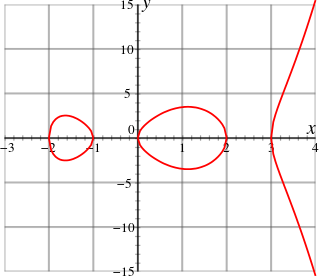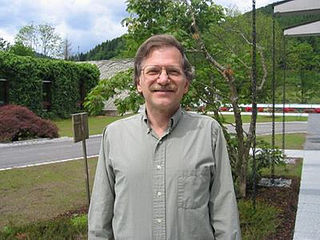Related Research Articles

In mathematics, an algebraic group is an algebraic variety endowed with a group structure that is compatible with its structure as an algebraic variety. Thus the study of algebraic groups belongs both to algebraic geometry and group theory.
In mathematics, a global field is one of two types of fields which are characterized using valuations. There are two kinds of global fields:
In mathematics, the arithmetic of abelian varieties is the study of the number theory of an abelian variety, or a family of abelian varieties. It goes back to the studies of Pierre de Fermat on what are now recognized as elliptic curves; and has become a very substantial area of arithmetic geometry both in terms of results and conjectures. Most of these can be posed for an abelian variety A over a number field K; or more generally.
In mathematics, the étale cohomology groups of an algebraic variety or scheme are algebraic analogues of the usual cohomology groups with finite coefficients of a topological space, introduced by Grothendieck in order to prove the Weil conjectures. Étale cohomology theory can be used to construct ℓ-adic cohomology, which is an example of a Weil cohomology theory in algebraic geometry. This has many applications, such as the proof of the Weil conjectures and the construction of representations of finite groups of Lie type.

In mathematics, a group scheme is a type of object from algebraic geometry equipped with a composition law. Group schemes arise naturally as symmetries of schemes, and they generalize algebraic groups, in the sense that all algebraic groups have group scheme structure, but group schemes are not necessarily connected, smooth, or defined over a field. This extra generality allows one to study richer infinitesimal structures, and this can help one to understand and answer questions of arithmetic significance. The category of group schemes is somewhat better behaved than that of group varieties, since all homomorphisms have kernels, and there is a well-behaved deformation theory. Group schemes that are not algebraic groups play a significant role in arithmetic geometry and algebraic topology, since they come up in contexts of Galois representations and moduli problems. The initial development of the theory of group schemes was due to Alexander Grothendieck, Michel Raynaud and Michel Demazure in the early 1960s.
In mathematics, algebraic geometry and analytic geometry are two closely related subjects. While algebraic geometry studies algebraic varieties, analytic geometry deals with complex manifolds and the more general analytic spaces defined locally by the vanishing of analytic functions of several complex variables. The deep relation between these subjects has numerous applications in which algebraic techniques are applied to analytic spaces and analytic techniques to algebraic varieties.

In mathematics, arithmetic geometry is roughly the application of techniques from algebraic geometry to problems in number theory. Arithmetic geometry is centered around Diophantine geometry, the study of rational points of algebraic varieties.

In mathematics, the absolute Galois groupGK of a field K is the Galois group of Ksep over K, where Ksep is a separable closure of K. Alternatively it is the group of all automorphisms of the algebraic closure of K that fix K. The absolute Galois group is well-defined up to inner automorphism. It is a profinite group.
In algebraic geometry, an étale morphism is a morphism of schemes that is formally étale and locally of finite presentation. This is an algebraic analogue of the notion of a local isomorphism in the complex analytic topology. They satisfy the hypotheses of the implicit function theorem, but because open sets in the Zariski topology are so large, they are not necessarily local isomorphisms. Despite this, étale maps retain many of the properties of local analytic isomorphisms, and are useful in defining the algebraic fundamental group and the étale topology.
The étale or algebraic fundamental group is an analogue in algebraic geometry, for schemes, of the usual fundamental group of topological spaces.
In mathematics, a Tate module of an abelian group, named for John Tate, is a module constructed from an abelian group A. Often, this construction is made in the following situation: G is a commutative group scheme over a field K, Ks is the separable closure of K, and A = G(Ks). In this case, the Tate module of A is equipped with an action of the absolute Galois group of K, and it is referred to as the Tate module of G.

In number theory and algebraic geometry, the Tate conjecture is a 1963 conjecture of John Tate that would describe the algebraic cycles on a variety in terms of a more computable invariant, the Galois representation on étale cohomology. The conjecture is a central problem in the theory of algebraic cycles. It can be considered an arithmetic analog of the Hodge conjecture.
This is a glossary of arithmetic and diophantine geometry in mathematics, areas growing out of the traditional study of Diophantine equations to encompass large parts of number theory and algebraic geometry. Much of the theory is in the form of proposed conjectures, which can be related at various levels of generality.

David Harbater is an American mathematician at the University of Pennsylvania, well known for his work in Galois theory, algebraic geometry and arithmetic geometry.
Michel Raynaud was a French mathematician working in algebraic geometry and a professor at Paris-Sud 11 University.
In mathematics, the flat topology is a Grothendieck topology used in algebraic geometry. It is used to define the theory of flat cohomology; it also plays a fundamental role in the theory of descent. The term flat here comes from flat modules.
In mathematics, the fundamental group scheme is a group scheme canonically attached to a scheme over a Dedekind scheme. It is a generalisation of the étale fundamental group. Although its existence was conjectured by Alexander Grothendieck, the first proof of its existence is due, for schemes defined over fields, to Madhav Nori. A proof of its existence for schemes defined over Dedekind schemes is due to Marco Antei, Michel Emsalem and Carlo Gasbarri.
In algebraic number theory, through completion, the study of ramification of a prime ideal can often be reduced to the case of local fields where a more detailed analysis can be carried out with the aid of tools such as ramification groups.
This is a glossary of algebraic geometry.
References
- ↑ Abhyankar, Shreeram (1957), "Coverings of Algebraic Curves", American Journal of Mathematics , 79 (4): 825–856, doi:10.2307/2372438 .
- ↑ Serre, Jean-Pierre (1990), "Construction de revêtements étales de la droite affine en caractéristique p", Comptes Rendus de l'Académie des Sciences, Série I (in French), 311 (6): 341–346, Zbl 0726.14021
- ↑ Raynaud, Michel (1994), "Revêtements de la droite affine en caractéristique p > 0", Inventiones Mathematicae, 116 (1): 425–462, Bibcode:1994InMat.116..425R, doi:10.1007/BF01231568, Zbl 0798.14013 .
- ↑ Harbater, David (1994), "Abhyankar's conjecture on Galois groups over curves", Inventiones Mathematicae, 117 (1): 1–25, Bibcode:1994InMat.117....1H, doi:10.1007/BF01232232, Zbl 0805.14014 .
- ↑ Fried, Michael D.; Jarden, Moshe (2008), Field arithmetic, Ergebnisse der Mathematik und ihrer Grenzgebiete. 3. Folge, vol. 11 (3rd ed.), Springer-Verlag, p. 70, ISBN 978-3-540-77269-9, Zbl 1145.12001